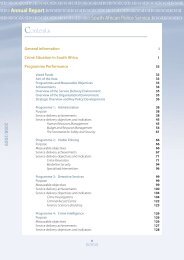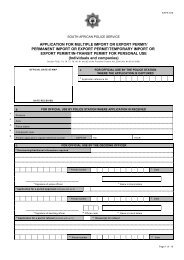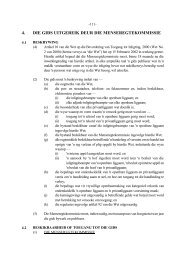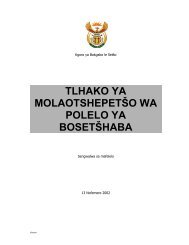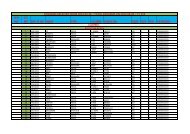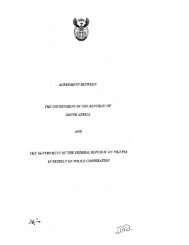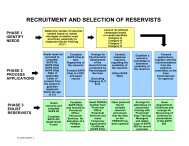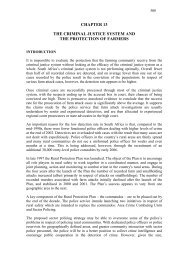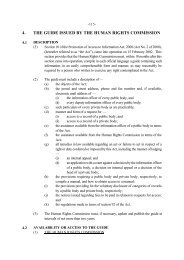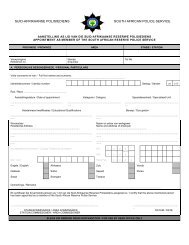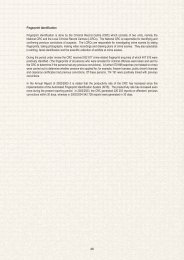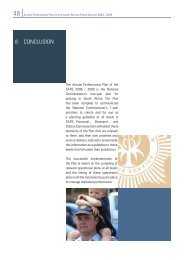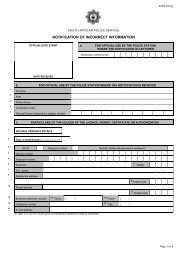Untitled - Saps
Untitled - Saps
Untitled - Saps
You also want an ePaper? Increase the reach of your titles
YUMPU automatically turns print PDFs into web optimized ePapers that Google loves.
1994/1995<br />
10 Years of Policing in a Democracy 1995 – 2005<br />
24<br />
• The previous 11 police agencies (the SAP and 10 former homeland agencies) and Non-<br />
Statutory Forces entered a process of amalgamation and rationalization to create a single<br />
police service, the SAPS, which functions at national and provincial levels. Policing in<br />
South Africa was traditionally dominated by various laws that were undemocratic and<br />
that were rejected by the majority of people in the country. However, transformation<br />
by means of community policing that would see a shift from a police force to a police<br />
service was in progress to establish an active partnership between the police and the<br />
community.<br />
• Mr Sydney Mufamadi was appointed Minister for Safety and Security. Mr Joe Matthews<br />
was appointed Deputy Minister for Safety and Security. Mr Azhar Cachalia was<br />
appointed Director-General for the Secretariat for Safety and Security.<br />
• The managerial style of the new SAPS began a process of transformation, moving from<br />
an autocratic, bureaucratic and militaristic style of command to a managerial style<br />
characterized by participation and problem-solving. This transformation entailed respect<br />
for, and sensitivity towards, the fundamental rights of all members of the community<br />
- including all members of the new SAPS.<br />
• As part of the government’s war on crime, a seven-point plan was announced<br />
in 1995 to improve the effectiveness of policing. The plan involved redeploying<br />
resources - both human and material; improving visible policing; arresting most-wanted<br />
suspects; supplying police stations in all the flashpoint areas with the necessary logistics to<br />
increase their effectiveness; restructuring border-control functions; utilizing technology<br />
such as helicopter video units in flashpoint areas; and setting tougher bail conditions for<br />
serious crimes.<br />
• A new basic training project for SAPS members, geared toward producing constables<br />
equipped for community policing, was launched.<br />
• The SAPS divisions included the following:<br />
Division Community Relations: The division had a consultative function and liaised<br />
internally with fellow police divisions and externally with communities to find solutions<br />
to problems and to formulate policies, priorities and strategies. The division mobilized<br />
all resources available to a community to resolve problems of disorder and to promote<br />
safety and security.<br />
Division Crime Combating and Investigation: The division consisted of the following units<br />
and bureaus:<br />
- A National Bureau for Missing Persons (established in October 1994), which worked<br />
closely with Crime Stop, a programme launched in 1993. (The programme has<br />
recovered stolen property and narcotics worth more than R1 billion since 1994.)<br />
- The Commercial Crime Unit, formerly known as the Commercial Branch, had<br />
its headquarters in Johannesburg. There were several Commercial Crime units<br />
throughout South Africa.<br />
- The Forensic Science Laboratory, which consisted of the Analytical Chemistry,<br />
Biology, Ballistics, Disputed Documents and Electronics Units.<br />
- The Diamond and Gold Branch which was charged with combating illicit dealing<br />
in, and possession of rough or uncut diamonds, semiprecious stones, tiger’s-eye and<br />
unwrought precious metal such as gold, silver and platinum.<br />
- The South African Narcotics Bureau, which combated drug-related crime on an<br />
organized and specialized basis throughout the country.<br />
- The Murder and Robbery units, which were stationed in Pretoria, Benoni, Soweto,<br />
Johannesburg, Krugersdorp, Durban, Port Elizabeth and Cape Town.<br />
- The Robbery Reaction Unit, which was formed to combat a wave of street robberies,<br />
handbag snatching and pick pocketing in central Johannesburg.



